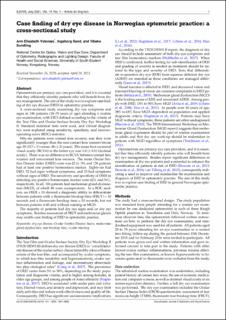| dc.contributor.author | Ystenæs, Ann Elisabeth | |
| dc.contributor.author | Sand, Ingeborg | |
| dc.contributor.author | Sundling, Vibeke | |
| dc.date.accessioned | 2022-02-03T09:56:25Z | |
| dc.date.available | 2022-02-03T09:56:25Z | |
| dc.date.created | 2021-11-03T10:40:43Z | |
| dc.date.issued | 2021 | |
| dc.identifier.citation | Ystenæs, A. E., Sand, I., & Sundling, V. (2021). Case finding of dry eye disease in Norwegian optometric practice: a cross-sectional study . Scandinavian Journal of Optometry and Visual Science, 14(1), 1–6. | en_US |
| dc.identifier.issn | 1891-0882 | |
| dc.identifier.uri | https://hdl.handle.net/11250/2976813 | |
| dc.description.abstract | Optometrists are primary eye care providers, and it is essentialthat they efficiently identify patients who will benefit from dryeye management. The aim of the study was to explore case find-ing of dry eye disease (DED) in optometric practice.A cross-sectional study examining dry eye symptoms andsigns in 186 patients (18–70 years of age) attending a routineeye examination, with DED defined according to the criteria ofthe Tear Film and Ocular Surface Society Dry Eye WorkshopII. Standard statistical tests were used, and clinical diagnos-tics were explored using sensitivity, specificity, and receiver-operating curve (ROC) statistics.Fifty-six patients were contact lens wearers, and they weresignificantly younger than the non-contact lens wearers (meanage 35 (SD= 1) versus 48 (± 2) years). The mean best correctedvisual acuity (BCVA) in the better eye was 1.0 (± 0.1) (decimalacuity). There was no difference in BCVA between contact lenswearers and non-contact lens wearers. The mean Ocular Sur-face Disease Index (OSDI) score was 22 (± 19), and 138 patientshad at least one positive homeostasis marker. Eighty-six hadDED, 52 had signs without symptoms, and 23 had symptomswithout signs of DED. The sensitivity and specificity of OSDI indetecting any positive homeostasis marker were 62% and 54%,respectively. In all, 106 patients had meibomian gland dysfunc-tion (MGD), of which 49 were asymptomatic. In a ROC anal-ysis, an OSDI ≥ 13 showed a diagnostic ability to differentiatebetween patients with a fluorescein breakup time (FBUT) < 10seconds and a fluorescein breakup time ≥ 10 seconds, but notbetween patients with and without staining or MGD.The majority of patients had dry eye signs and/or dry eyesymptoms. Routine assessmentofFBUT and meibomian glandsmay enable case finding of DED in optometric practice. | en_US |
| dc.language.iso | eng | en_US |
| dc.relation.uri | https://www.sjovs.org/index.php/SJOVS/issue/view/26/19 | |
| dc.rights | Navngivelse 4.0 Internasjonal | * |
| dc.rights.uri | http://creativecommons.org/licenses/by/4.0/deed.no | * |
| dc.title | Case finding of dry eye disease in Norwegian optometric practice: a cross-sectional study | en_US |
| dc.type | Peer reviewed | en_US |
| dc.type | Journal article | en_US |
| dc.description.version | publishedVersion | en_US |
| dc.rights.holder | © 2021 The Author(s). | en_US |
| dc.source.pagenumber | 1-5 | en_US |
| dc.source.volume | 14 | en_US |
| dc.source.journal | Scandinavian Journal of Optometry and Visual Science | en_US |
| dc.source.issue | 1 | en_US |
| dc.identifier.doi | https://doi.org/10.5384/sjovs.v14i1.131 | |
| dc.identifier.cristin | 1950895 | |
| cristin.ispublished | true | |
| cristin.fulltext | original | |
| cristin.qualitycode | 1 | |

